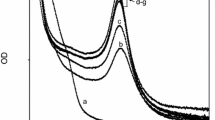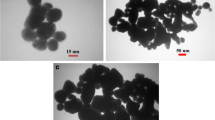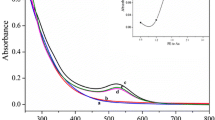Abstract
The authors describe the preparation of gold nanoparticles (AuNPs) coated with poly(ethylene glycol)-block-poly(propylene glycol)-block-poly(ethylene glycol) (Pluronic F-108) by reducing Au3+ to Au0 using curcumin, a natural and non-toxic food spice, in water of pH ~7 in the presence of F-108 and Ag+ ion. The coated AuNPs display strong resonance Rayleigh scattering (RRS) and fluorescence that results from the functionalization of the gold surface with curcumin and Pluronic F-108. The molar mass of Pluronic F-108 affects the particle size of the AuNPs formed, and small AuNPs are formed when using low molar weight F-108 that was purified by centrifugation or dialysis. The coated AuNPs were employed in an optical method for the determination of uric acid. The combination of uric acid with the AuNPs boosts both the RRS signal and the fluorescence of the AuNPs. However, higher concentrations of uric acid shift the fluorescence peak to shorter wavelengths. The method is simple, and fluorescence, best measured at excitation/emission wavelengths of 425/534 nm, increases linearly in the 50 μM to 50 mM uric acid concentration range, with a 0.14 μM detection limit which is lower than reported for other methods in the literature.

Pluronic F-108 capped gold nanoparticles prepared by reducing Au3+ to Au0 using curcumin can estimate uric acid in 50 μM to 50 mM concentration range.






Similar content being viewed by others
References
Sindhu K, Rajaram KA, Sreeram KJ, Rajaram R (2014) Curcumin conjugated gold nanoparticle synthesis and its biocompatibility. RSC Adv 4:1–11
Dreaden EC, Alkilany AM, Huang X, Murphy CJ, El-Sayed MA (2012) The golden age: gold nanoparticles for biomedicine. Chem Soc Rev 41:2740–2779
Matsui J, Akamatsu K, Hara N, Miyoshi D, Nawafune H, Tamaki K, Sugimoto N (2005) SPR sensor Chip for detection of small molecules\rUsing molecularly imprinted polymer with\rEmbedded gold nanoparticles. Anal Chem 77(13):4282–4285
Lu Y (2003) A colorimetric lead biosensor using DNAzyme- directed assembly of gold nanoparticles. J Am Chem Soc 125:6642–6643
Zhang S, Wang N, Yu H, Niu Y, Sun C (2005) Covalent attachment of glucose oxidase to an au electrode modified with gold nanoparticles for use as glucose biosensor. Bioelectrochemistry 67(1):15–22
Daniel MCM, Astruc D (2004) Gold nanoparticles: assembly, supramolecular chemistry, quantum-size related properties and applications toward biology, catalysis and nanotechnology. Chem Rev 104(1):293–346
Liu H, Hou P, Zhang W, Kim YK, Wu J (2010) The synthesis and characterization of polymer coated FeAu multifonctional nanoparticles. Nanotech 21(33):1–9
Bobulescu IA, Moe OW (2012) Renal transport of uric acid: evolving concepts and uncertainties. Adv Chronic Kidney Dis 19(6):358–371
Kannan P, John SA (2009) Determination of nanomolar uric and ascorbic acids using enlarged gold nanoparticles modified electrode. Anal Biochem 386(1):65–72
Popa E, Kubota Y, Tryk DA, Fujishima A (2000) Selective voltammetric and amperometric detection of uric acid with oxidized diamond film electrodes. Anal Chem 72(7):1724–1727
Bravo R, Hsueh CC, Jaramillo A, Brajter-Toth A (1998) Possibilities and limitations in miniaturized sensor design for uric acid. Analyst 123(7):1625–1630
Chen X, Wu G, Cai Z, Oyama M, Chen X (2014) Advances in enzyme-free electrochemical sensors for hydrogen peroxide, glucose, and uric acid. Microchim Acta 181:689–705
Kayamori Y, Katayama Y, Urata T (2000) Nonenzymatic elimination of ascorbic acid in clinical samples. Clin Biochem 33:25–29
Matos RC, Augelli MA, Lago CL, Angnes L (2000) Flow injection analysis-amperometric determination of ascorbic and uric acids in urine using arrays of gold microelectrodes modified by electrodeposition of palladium. Anal Chim Acta 404(1):151–157
Umasankar Y, Thiagarajan S, Chen SM (2007) Nanocomposite of functionalized multiwall carbon nanotubes with nafion, nano platinum, and nano gold biosensing film for simultaneous determination of ascorbic acid, epinephrine, and uric acid. Anal Biochem 365(1):122–131
Wei Y, Li M, Jiao S, Huang Q, Wang G, Fang B (2006) Fabrication of CeO2 nanoparticles modified glassy carbon electrode and its application for electrochemical determination of UA and AA simultaneously. Electrochim Acta 52(3):766–772
Dyal C, Nguyen N, Hadden J, Gou L, Murphy CJ (2006) Green synthesis of gold and silver nanoparticles from plant extracts. Chem Mater 231:301–315
Rawat KA, Kailasa SK (2014) Visual detection of arginine, histidine and lysine using quercetin-functionalized gold nanoparticles. Microchim Acta 181(15–16):1917–1929
Rawat KA, Singhal RK, Kailasa SK (2017) One-pot synthesis of silver nanoparticles using folic acid as a reagent for colorimetric and fluorimetric detections of 6-mercaptopurine at nanomolar concentration. Sens Actuat B: Chemical 249:30–38
Rawat KA, Kailasa SK (2016) 4-amino nicotinic acid mediated synthesis of gold nanoparticles for visual detection of arginine, histidine, methionine and tryptophan. Sens Actuat B: Chemical 222:780–789
Moussawi RN, Patra D (2015) Synthesis of au Nanorods through Prereduction with curcumin: preferential enhancement of au Nanorod formation prepared from CTAB-capped over citrate-capped au seeds. J Phys Chem C 119:19458–19468
El Kurdi R, Patra D (2017) The role of OH- in the formation of highly selective gold nanowires at extreme pH: multi-fold enhancement in the rate of the catalytic reduction reaction by gold nanowires. Phys Chem Chem Phys 19:5077–5090
Mouslmani M, Patra D (2014) Revoking excited state intra-molecular hydrogen transfer by size dependent tailor-made hierarchically ordered nanocapsules. RSC Adv 4:8317
Patra D, Ahmadieh D, Aridi R (2013) Study on interaction of bile salts with curcumin and curcumin embedded in dipalmitoyl-sn-glycero-3-phosphocholine liposome. Colloids Surf B: Biointerfaces 110:296–304
Huang X, El-Sayed MA (2010) Gold nanoparticles: optical properties and implementations in cancer diagnosis and photothermal therapy. J Adv Res 1(1):13–28
Boisselier E, Astruc D (2009) Gold nanoparticles in nanomedicine: preparations, imaging, diagnostics, therapies and toxicity. Chem Soc Rev 38(6):1759–1782
Greenberg MA, Hershfield MA (1989) A radiochemical-high-performance liquid chromatographic assay for urate oxidase in human plasma. Anal Biochem 176(2):290–293
Ghman G (1979) Evaluation of three clinical chemical routine methods for the determination of serum uric acid by mass fragmentography. Clin Chim Acta 95:219–226
Trivedi RC, Rebar L, Berta E, Stong L (1978) New enzymatic method for serum uric acid. Clin Chem 24(11):1908–1911
Liu J, Li GX, Liu H, Zhou X (1994) Purification and properties of Uricase from Candida Sp. and its Aplplication in uric acid analysis in serum. Appl Biochem Biotechnol 47:57–69
Acknowledgements
Financial support provided by Lebanese National Council of Scientific Research (NCSR), Lebanon and American University of Beirut, Lebanon through URB as well as Kamal A. Shair Central Research Laboratory (KAS CRSL) facilities to carry out this work is greatly acknowledged.
Author information
Authors and Affiliations
Corresponding author
Ethics declarations
The author(s) declare that they have no competing interests.
Electronic supplementary material
ESM 1
(DOCX 779 kb)
Rights and permissions
About this article
Cite this article
El Kurdi, R., Patra, D. Gold nanoparticles functionalized with Pluronic are viable optical probes for the determination of uric acid. Microchim Acta 185, 185 (2018). https://doi.org/10.1007/s00604-018-2725-6
Received:
Accepted:
Published:
DOI: https://doi.org/10.1007/s00604-018-2725-6




